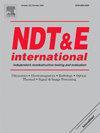Grouting quality detection of prestressed tendon ducts using array ultrasonic tomography
IF 4.1
2区 材料科学
Q1 MATERIALS SCIENCE, CHARACTERIZATION & TESTING
引用次数: 0
Abstract
The grouting quality inspection of prestressed tendon ducts is crucial for detecting internal defects in prestressed structures. However, accurately assessing the grouting compactness within tendon ducts remains a significant challenge. To explore the feasibility and effectiveness of using array ultrasound for evaluating the grouting quality of prestressed ducts, this study proposes a method that leverages an improved deep learning model for identifying ducts and a technique based on ultrasound C-scan images for grouting quality assessment. Specifically, (1) by utilizing the proposed improved target detection model YOLOV7-SE, automatic recognition and localization of ducts in ultrasound images are achieved, which aids in selecting the appropriate depth range for C-scan image; (2) based on laboratory test results, criteria and procedures for assessing grouting quality using array ultrasound C-scan images are established. Ultrasound testing on simulated prestressed box beam top and web plates shows that the improved model accurately locates and marks the positions of tendon ducts, providing a reliable basis for setting the depth of ultrasound C-scan images. The reflective characteristics of the ultrasound C-scan images allow for a qualitative assessment of the grouting quality within the inspected area. The feasibility of the proposed method has been effectively validated through laboratory tests and field inspections.

阵列超声层析成像检测预应力筋管注浆质量
预应力筋管灌浆质量检测是检测预应力结构内部缺陷的关键。然而,准确评估肌腱管内注浆密实度仍然是一个重大挑战。为探索阵列超声评价预应力管道注浆质量的可行性和有效性,本研究提出了一种利用改进的深度学习模型进行管道识别的方法和基于超声c扫描图像的注浆质量评价技术。具体而言,(1)利用提出的改进目标检测模型YOLOV7-SE,实现了超声图像中导管的自动识别和定位,有助于c扫描图像选择合适的深度范围;(2)根据室内试验结果,建立了阵列超声c扫描图像评价注浆质量的标准和程序。对模拟预应力箱梁顶板和腹板的超声检测表明,改进的模型能够准确定位和标记肌腱导管的位置,为超声c扫描图像深度的设置提供了可靠的依据。超声c扫描图像的反射特性可以对检测区域内的注浆质量进行定性评价。通过实验室试验和现场检验,有效验证了该方法的可行性。
本文章由计算机程序翻译,如有差异,请以英文原文为准。
求助全文
约1分钟内获得全文
求助全文
来源期刊

Ndt & E International
工程技术-材料科学:表征与测试
CiteScore
7.20
自引率
9.50%
发文量
121
审稿时长
55 days
期刊介绍:
NDT&E international publishes peer-reviewed results of original research and development in all categories of the fields of nondestructive testing and evaluation including ultrasonics, electromagnetics, radiography, optical and thermal methods. In addition to traditional NDE topics, the emerging technology area of inspection of civil structures and materials is also emphasized. The journal publishes original papers on research and development of new inspection techniques and methods, as well as on novel and innovative applications of established methods. Papers on NDE sensors and their applications both for inspection and process control, as well as papers describing novel NDE systems for structural health monitoring and their performance in industrial settings are also considered. Other regular features include international news, new equipment and a calendar of forthcoming worldwide meetings. This journal is listed in Current Contents.
 求助内容:
求助内容: 应助结果提醒方式:
应助结果提醒方式:


